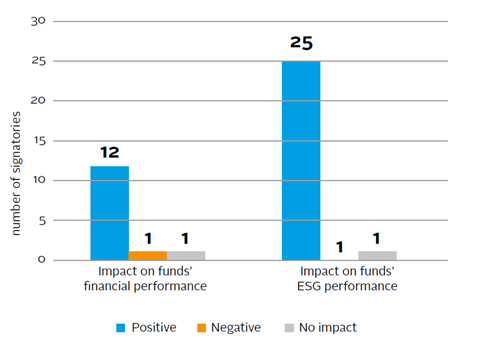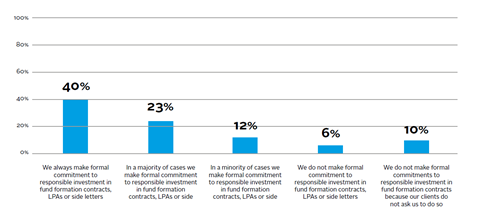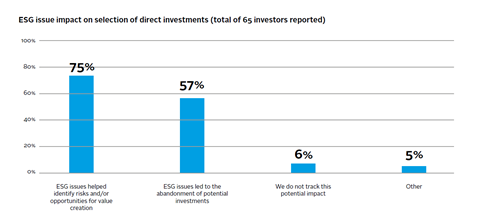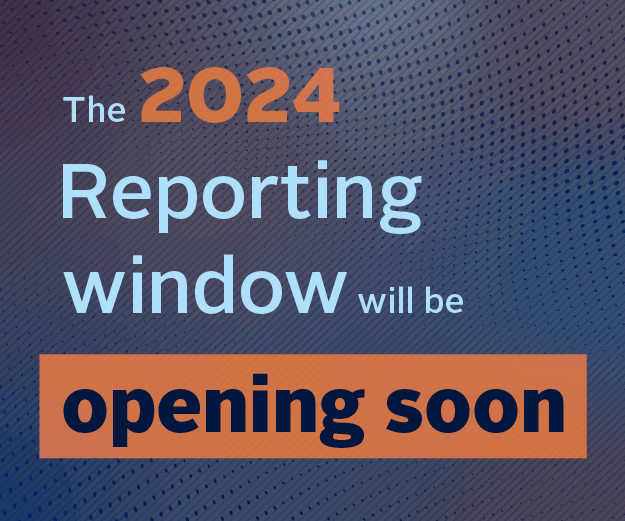Principle 1 states ’We will incorporate ESG issues into investment decision making processes’
Incorporating ESG refers to both the approach of the investor organisation as a whole, including resourcing, strategy and governance, and to how the organisation’s approach to ESG incorporation is implemented in the investment process. Some of the ways investors can implement Principle 1 are described below.
Responsible investment in organisational governance, policy and strategy
- Organisational governance: Train and educate staff to consider and integrate ESG into decision-making throughout the investment process (including due diligence, post-investment monitoring, value creation activities, and risk and compliance monitoring).
- Policy and strategy: Formalise your ESG approach into a policy. Many investors will have an organisation-wide ESG policy that covers all asset classes. Adapting this into a specific policy for infrastructure will help align expectations and practices on responsible investment in infrastructure. A policy covering all asset classes is likely to leave space for interpretation on its application to infrastructure. Integrate the responsible investment policy into a practical implementation strategy so that investment professionals are equipped with practical methods for living up to the firm’s policy.
- Portfolio construction: Incorporate ESG matters into asset allocation and portfolio diversification (e.g. asset concentration issues with respect to climate change risk, leverage).
Example: AMP Capital’s infrastructure ESG toolbox
The Infrastructure ESG Toolbox was designed to address the need for specialist knowledge relating to multi-faceted ESG factors across a diverse range of sub-sectors and regions of the global investment landscape. The Toolbox comprises a collection of internationally recognised best practice guidelines and sector-specific resources, designed to assist the infrastructure investment team in dealing with ESG issues of varying materiality. The Toolbox’s resources supplement existing investment policies and are utilised throughout investment decision-making and ongoing asset management activities.
Integrating ESG in indirect infrastructure investment (funds)
- Investor selection of fund managers. Incorporate ESG in due diligence when selecting infrastructure fund managers, including requiring managers to disclose how they will incorporate ESG factors into their investment decision-making, monitoring and reporting processes. Request examples from previous funds - or in the case of new managers, from individuals’ previous roles. Refer to existing PRI guidance in the appendix.
- Assess or rate managers on their approach to integrating ESG analysis, where appropriate, into risk frameworks and the investment decision-making process. This can help investors evaluate overall alignment with their responsible investment policy and encourage fund managers to improve their ESG integration.
- Fund manager appointments. Request the incorporation of ESG provisions in fund terms, including Limited Partnership Agreements and side letters. Refer to existing PRI guidance in the appendix.
- Fund manager monitoring. Use ESG topics covered during selection, as well as the provisions included or discussed when agreeing fund terms, as a foundation for monitoring ESG considerations. Request periodic reports on engagement activities and ESG performance. Set clear expectations for when and how the fund manager should report material, adverse ESG incidents. Provide examples to illustrate what you consider severe and what constitutes a material ESG incident.
Example: Swen Capital Partners’ ESG controversy monitoring
SWEN Capital Partners is an asset manager specialising in responsible investments for private markets. The organisation has established an in-house monitoring system for ESG controversies concerning its direct investments as well as for the largest underlying portfolio companies in the funds in which it invests indirectly. The checks are carried out internally by SWEN Capital Partners f ESG team via daily press reviews and monitoring tools (Thompson Reuters Worldcheck, Google Alerts, support from holding company OFI fs ESG team etc). This allows SWEN Capital Partners to classify ESG incidents into three levels:
- serious controversy (controversy that is likely to call into question the licence to operate);
- significant controversy (controversy that has a significant financial and/or reputational impact on the company);
- light controversy (controversy with limited financial and/or reputational impact for the company). The in-house controversy tracking system also allows SWEN Capital Partners to access positive information about companies’ consideration of ESG.
Linking ESG integration to outcomes
A small number of PRI signatories reported in 2017 on the voluntary indicators relating to ESG and financial performance in the Direct Infrastructure module of the PRI Reporting Framework. The graph below shows the perceived links between ESG integration and investment outcomes both in terms of financial performance and the ESG performance of the fund or portfolio as a whole.


Download the full report
-

Primer on responsible investment in infrastructure
January 2018

Integrating ESG in infrastructure investment (direct)
- ESG requirements in the investment policy and process. Set requirements for completing environmental and/or social impact assessments and fulfilling ESG criteria in different phases of the investment process (primarily due diligence and ownership) using third-party expertise if necessary.
- Origination. Consider potential current and future exposure to ESG risks and opportunities in your investment universe when sourcing investment opportunities. This can include technology; site; engineering, procurement, and construction (EPC) contractors and suppliers; region; sector; regulatory and policy environment; and impact targets of relevant stakeholders. It can include your ability to deal with these risks and seize these opportunities across the field of potential investments.
- Screening. Include ESG risks in exclusion checklists and as mandatory parts of screening reports and pre-investment approvals. Screening should identify any potential ESG deal breakers and can also be used to detect ESG factors to be explored in detailed due diligence. Possible considerations include reputational concerns such as human rights abuses and harmful environmental practices.
57% of direct infrastructure investor reporters stated that ESG issues led to the abandonment of potential investments
- Due diligence. Given that ESG considerations can have both a positive and negative impact on returns, treat ESG matters like other aspects of due diligence by assessing risks, the ESG track record of the business or asset, and opportunities. Consider ESG factors throughout the full life cycle of the business (development, construction, operation, maintenance, decommissioning), including an assessment of impacts and risks in the supply chain, such as manufacturing and transport.
- Preparing for post-acquisition activities. On the basis of due diligence findings, create management and remediation strategies for material ESG risks, including mitigation, pricing, transfer and monitoring. Include any ESG opportunities for increased returns in a post-acquisition value preservation and creation plan. The consideration of both material ESG risks and opportunities for value preservation and creation in post-acquisition plans can be made a condition of Investment Committee approval. Where risk mitigation is not possible, consider declining the investment opportunity.
- ESG in valuations and transactions (including exits). Attribute value to ESG factors throughout the life cycle of the investment, including potential ESG incidents, issues and impacts, to encourage the consideration of ESG costs and associated benefits.
Identifying ESG risks and opportunities in due diligence
- Assessing potential environmental and social impacts of investee companies and assets may not only influence the investment decision but also prepares for risk management during the holding period.
- Due diligence should cover the business track record on the management of ESG risk, such as: existence of policies and systems relating to sustainability and ESG issues, the coverage of these policies and their governance; track record on health and safety performance; responsibility for sustainability and ESG within the business; track record on ESG performance improvements in line with sustainability policies and procedures; track record on monitoring and reporting to the board, shareholders and other stakeholders on ESG policy implementation and on progress on performance targets.
- For newly created businesses and companies, due diligence should include the track record of past and current management activities.
- Assessing risks and existing practices can also highlight opportunities for protecting value and improving the revenue and risk profile of the investment. These include, for example, energy efficiency, high-performance buildings, waste reduction, stakeholder engagement and potential for obtaining environmental certificates.
Other considerations
- Minority shareholders and debt investors. When investing as a minority shareholder or lender, undertake ESG due diligence on the lead sponsor, its dialogue with the management of the infrastructure business and its existing ESG approach. Assess whether the majority shareholder is aligned with your views on responsible investment and whether it is willing to listen to minority shareholders or debt investors..
- Fundraising. Incorporate ESG into your offering documents, specifying the role of ESG factors in your investment strategy and describing how you have integrated ESG throughout the investment process, including pre-investment activities, post-investment activities, and reporting to investors. Make your ESG policy available to existing and prospective investors.
Download the full report
-

Primer on responsible investment in infrastructure
January 2018
Topics
Primer on responsible investment in infrastructure
- 1
- 2
- 3
- 4
 Currently reading
Currently readingApplying Principle 1
- 5
- 6
- 7
- 8
- 9
- 10
- 11























